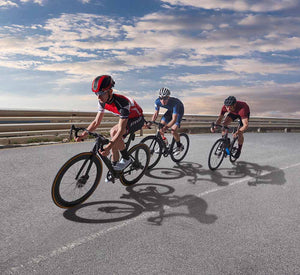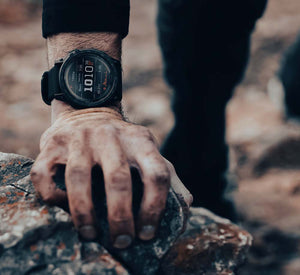
COROS Pace Pro Review: The Best COROS Running Watch Yet?
The COROS Pace Pro is the first COROS GPS watch to pack a bright smartwatch-style AMOLED display. That’s the big news. But this new COROS watch also adds offline maps, more storage, and ECG heart rate smarts. So is this running-focussed tracker the best budget-friendly AMOLED you can buy? I spent a month running with the COROS Pace Pro to find out.
The COROS Pace Pro brings a bright AMOLED screen to a COROS watch for the first time. It’s a big step forward for COROS, joining the AMOLED arms race against watches like the Garmin Forerunner 265, the Polar Vantage M3 and the Suunto Race. But in addition to that bigger, brighter screen, you also get a longer battery life than the COROS Pace 3, improved navigation skills with offline maps, an ECG sensor, more storage, and faster processing for snappier taps and swipes.
That’s all delivered in a watch that’s designed to be lightweight and easy to wear 24-7. Behind the hardware, the COROS Pace Pro offers an identical suite of training, performance, recovery, and health-tracking as the Pace 3 and COROS’ pricier Apex Pro and Vertix 2 watches. Though it misses out on some of the outdoor sport modes like climbing and watersports.
So is this the best COROS running watch yet? I spent a month testing the new COROS Pace Pro to find out. Read on for the verdict in my COROS Pace Pro review.
COROS Pace Pro: An Introduction
The COROS Pace Pro is jostling for position among the best running watches, in the increasingly competitive mid-range section.
In COROS’ line-up it sits between the cheapest, entry-level COROS Pace 3 and the more rugged COROS Apex 2.
It’s a light, streamlined multisport watch with an excellent 1,500 nit display that’s easy to read in all lights and brings your stats and maps to life.
Beyond that you’ve got a simple design that’s functional rather than fancy and broadly speaking, you get the same feature set as you’ll find on COROS’ more premium multisport watches. Plus the same sensor selection as the Vertix and Apex series, including ECG, barometric altimeter and SpO2 sensor. You also get the same 50 meters water resistance.
It offers an impressive set of COROS Evo Lab training tools, good navigation smarts, and excellent staying power. All of the core essentials are well catered for. Though it lacks some of the smartwatch tools you now find on Garmin, like contactless payments and offline support for music services like Spotify and Deezer.
COROS Pace Pro: How I Tested
For this review, I spent a month wearing the COROS Pace Pro 24-7. I trained with it, slept with it and put it up against the likes of the more advanced Garmin fenix 8 AMOLED, the Suunto Race Titanium S, and the Polar Vantage M3 along with a Garmin HRM Pro+ chest strap.
I’ve analyzed my training data, dug deep into the GPS tracks and the heart rate charts to see how it compares for comfort, features, accuracy and battery life.
COROS Pace Pro: Models, Sizes & Prices
The COROS Pace Pro comes in just one 46mm size and three colors: black, great and blue. The Pace Pro ships with a swappable 22m silicon strap. Unlike the COROS Pace 3, you don’t get to choose between a silicon and nylon strap at purchase. But you can buy nylon straps separately for an additional $29.
At launch, the COROS Pace Pro price was $349. That’s $100 cheaper than the Garmin Forerunner 265 and the Suunto Race which both come in at $449 and $50 cheaper than the Polar Vantage M3 at $399.95)
COROS Pace Pro vs Pace 3: What’s the Difference?
If you’re trying to work out which is the best COROS running watch, the most obvious difference between the COROS Pace Pro and the COROS Pace 3 is that larger, brighter, higher quality AMOLED touchscreen. But you’re also getting longer battery life in the most accurate GPS modes, offline TOPO maps, more storage for maps and music, an ECG sensor and a faster processor.
There’s new hardware too with an updated heart rate sensor, new GPS chipset and antenna and a new battery.
The COROS Pace Pro’s 1.3-inch screen offers marginally more real estate than the 1.2-inch, lower resolution Memory-in-Pixel (MIP) display on the COROS Pace 3. But beyond the screens, there’s not much difference in design. The bezel and casing use the same fibre-reinforced polymer. These are cheaper-looking devices.
However, those lighter materials help to save weight. The COROS Pace Pro weighs in at 10g heavier than the COROS Pace 3 with the silicon band. There’s just 7g between them if you opt for a nylon band.
The COROS Pace Pro packs more run time in the higher accuracy GPS modes than you get from the COROS Pace 3. There’s 31 hours versus 15 hours in Dual Frequency versus and 38 hours versus 25 hours in the All Systems mode. General smartwatch usage is also boosted from 15 to 20 days.
You’ll pay for those screen and battery upgrades. The COROS Pace 3 costs $229 while the COROS Pace Pro lands at $349.
COROS Pace Pro: Battery Life
COROS’ USP has always been excellent staying power and the COROS Pace Pro manages to add an AMOLED screen while still increasing the battery life. It now goes longer than the regular Memory-in-Pixel display on the Pace 3. That’s impressive.
On paper the COROS Pace Pro battery life is listed at 31 hours using the Dual Frequency GPS. That rises to 38 hours in All Systems GPS mode. You get 20 days in smartwatch mode without the Always On screen.
In testing, the COROS Pace Pro impressed. Particularly with the Always On screen set to off. In the max GPS accuracy mode, using dual frequency GPS, it used half the battery of the Polar Vantage M3 and the COROS Pace 3.
Here are some other headlines:
- A 1-hour run using All Systems GPS burned 2%
- A 2-hour run using All Systems GPS burned 6%
- A 1-hour run using Max Accuracy Dual Frequency mode burned 2%
- The average daytime usage with no training was around 2%
- The average overnight burn was 2%
In total, I got 17 days of general usage with 7.5 hrs GPS training and an hour of indoor heart-rate cardio.
The performance dropped when I switched to the Always On screen. But not by much.
- A 1-hour run with All Systems GPS/Always On burned 3%
- A 1-hour run with Max Accuracy Dual Frequency/Always On burned 3%
- The average overnight burn was around 3%
At the time of writing, the COROS Pace Pro had used around 50% battery over 6 days with 4 hours GPS training.
COROS Pace Pro: Running, Fitness and Health Features
Where hardware permits, COROS is great at making its features available across the range. So when it comes to sports tracking, the COROS Pace Pro offers largely the same comprehensive selection of sport modes, training, performance, recovery, and health tools as the COROS Vertix 2S and the Apex Pro 2. There’s just a few more adventurous activities saved for its top-tier rugged watches.
Running, cycling, swimming are well catered for. Runners get indoor, trail, and track modes, along with running power from the wrist. Swimmers have indoor and outdoor modes. Plus there’s triathlon mode to cater for the swim–bike-runners. So this is a good option as a triathlon watch.
When it comes to training and fitness insights, you get all the usual suspects including training effect, training status, training load, recovery, fatigue, virtual pacer, race time predictor, VO2 max estimates, threshold zones, training plans, and interval training.
Pretty much everything you need to train, race and recover with a slick-looking partner app that lets you dig deeper into the details.
Health smarts include ECG – so you can take timed and intentional Heart Rate Variability reads. Plus there’s continuous HRV, activity, stress, and sleep tracking.
COROS Pace Pro: Mapping and Navigation
The inclusion of offline color topographical maps is a welcome upgrade to the Pace Pro. It sets it apart from the Garmin Forerunner 265 which doesn’t. Plus having that big AMOLED really helps bring them to life.
It also offers route planning and sync (though you have to do the latter manually) and turn-by-turn navigation with off-course alerts. It still lacks the really useful ClimbPro-style feature that serves up useful details on the climbs and descents left on your route and how long until you summit the ascent you’re on. Both Polar and Garmin offer these on their similarly-priced watches.
You can also use COROS’ unique extender mode to beam your watch screen to a smartphone for a better view.
COROS Pace Pro: Smartwatch Tools
When it comes to smartwatch tools, this is one area where COROS is still behind Garmin and a long way off the life-taming features of a sports-friendly smartwatch like the Apple Watch Series 10.
You’re limited to notifications from a paired smartphone. There’s offline music storage and phone-free playback – which puts it ahead of the Polar Vantage M3 and Suunto Race which only offer music controls. But you’ll need to own music files to make the most of that. There’s no Spotify support. There’s also no contactless payments or voice tools.
The COROS Pace Pro watch face isn’t as customizable as Polar and Garmin and the selection of watch face designs definitely don’t float everyone’s boat.
But if you’re regularly filming with a GOPro or Insta360 camera, the action camera controls are handy.
COROS Pace Pro: Heart Rate and GPS Accuracy
The COROS Pace Pro offers multiband/dual frequency GPS and has a new GPS chipset and antenna in a bid to dial in that accuracy even better.
I tested the COROS Pace Pro GPS accuracy and heart rate reliability against a selection of rivals, including the Suunto Race S Titanium and the Polar Vantage M3. I also used a Garmin HRM Pro+ chest strap and the top-tier Garmin fenix 8 AMOLED as a benchmark.
My test runs were mainly around semi built-up urban streets with some open sky park runs and tree-covered river paths thrown in. I also hit the sauna for some heat training.
I switched up the power and GPS accuracy modes from the All Systems + Dual Frequency Max Accuracy, down to All Systems Only mode that, in theory, sacrifices some accuracy for staying power.
In testing, the dual frequency GPS performed well against the pricier Garmin Fenix 8 for total distances and stuck us to tracks with good reliability. Not 100% perfect but no more fallible than any of the other watches on test.
Bottom Line: Should You Buy the COROS Pace Pro?
The COROS Pace Pro is a very capable watch that packs plenty of features and tracking firepower for the price. There’s more than enough here to cover most runner’s needs and though it lacks some of the smarts and finesse you’ll get with rival Garmin watches, it represents good value.
If we’re being kind, we’d say the design is simpler than the Polar Vantage M3, Suunto Race and the Garmin Forerunner 265 but you’re definitely swapping some looks for a lighter, cheaper build.
This is the best COROS watch to buy if you’re looking for a capable sports watch with a killer screen, the longest lasting AMOLED battery life and better navigation.
If you already own a COROS Pace 3 and you’re not bothered about the AMOLED screen or the maps, then it’s not worth upgrading. If you’re a newcomer and the screen and maps aren’t priorities, save yourself some dollars and go for the COROS Pace 3.
About Journalist Kieran Alger
Co-founder of The Run Testers, Kieran Alger is an experienced journalist who has spent more than a decade testing running gear. Regularly found wearing four GPS running watches at once, if it claims to make you run better or enjoy running more, he has probably tested it. He's a borderline obsessed runner with more than 50 marathon and multiple ultra finishes. In 2022, he became the first person to run Europe's river Danube from sea to source, a measly 1,830 miles in 66 days. And still had time to test running gear.
Check him out on Instagram or his YouTube Channel!
















